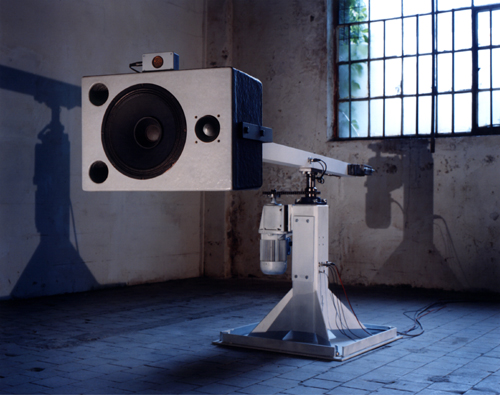
Marnix de Nijs & Edwin van der Heide, Spatial Sounds
Deep Screen – Art in Digital Culture
Proposal for Municipal Art Acquisitions 2008
30.05.08 - 30.09.08
Deep Screen – Art in Digital Culture presents contemporary works of art which are all in some way marked by today’s digital culture. The jury, chaired by guest curator Andreas Broeckmann, has selected 18 artists out of the 200-plus submissions.
In the course of the exhibition at the Stedelijk Museum CS, director Gijs van Tuyl will select works to be acquired for the museum’s collection.
Click here below for an impression of the exhibition in Stedelijk Museum CS:
Windows Mediaplayer Video>>
more info
http://www.stedelijk.nl/oc2/page.asp?PageID=1808
=============
I visited the exhibition yesterday and took this footage.
Spatial Sounds (100dB at 100km/h) is an interactive audio installation by Marnix de Nijs and Edwin van der Heide. In this engine-powered installation, a speaker is mounted onto a rotating arm that is several meters long. Like a watchdog, the machine scans the surrounding space for visitors. Closer investigation would be tempting fate, with the rotating arm swinging so powerfully round. You hear the impressive sound of the mighty motor revving up, turning faster and faster. You can feel the displacement of air as the speaker whizzes past you, and you had better step back, out of reach. The machine slows down and, when the shock wears off, you start exploring the space, with your movements manipulating the sound it produces. Just don't get too close! Spatial Sounds (100dB at 100km/h) builds up a physically tangible relationship with the visitor, since it is the game of attracting and repelling between machine and visitor that determines its sound and movement.
more info
http://www.evdh.net/spatial_sounds/index.html
Technical details: The sound and movements of Spatial Sounds (100dB at 100km/h) are generated in real-time, and the algorithms for generating these are defined very precisely. However, the actual sounds depend very much on what visitors do with the installation. On top of the speaker is a sonar sensor that measures the distance between visitors and objects and the speaker. The sensor takes its measurements from a beam facing away from the speaker, and there is also an angle sensor mounted on the axis of the installation. The data from both sensors are transmitted to the computer that generates the sound. When the installation is placed in a room, it first learns the shape of this room while it is still empty. In this way, it can distinguish between people in a space and the space itself. Thereafter, the computer is able to recognize the various visitors to the space. Spatial Sounds (100dB at 100km/h) reacts in different ways to its visitors. It can react with movement and/or sound to the behavior of individuals or to visitors in general. And besides reacting to visitors, the sound is also directly related to the speed of the arm and the shape of the room around it.
No comments:
Post a Comment